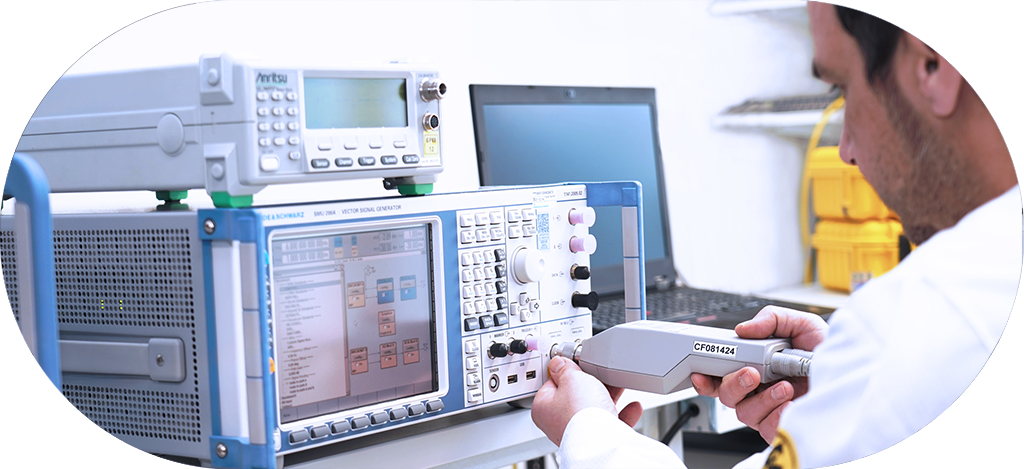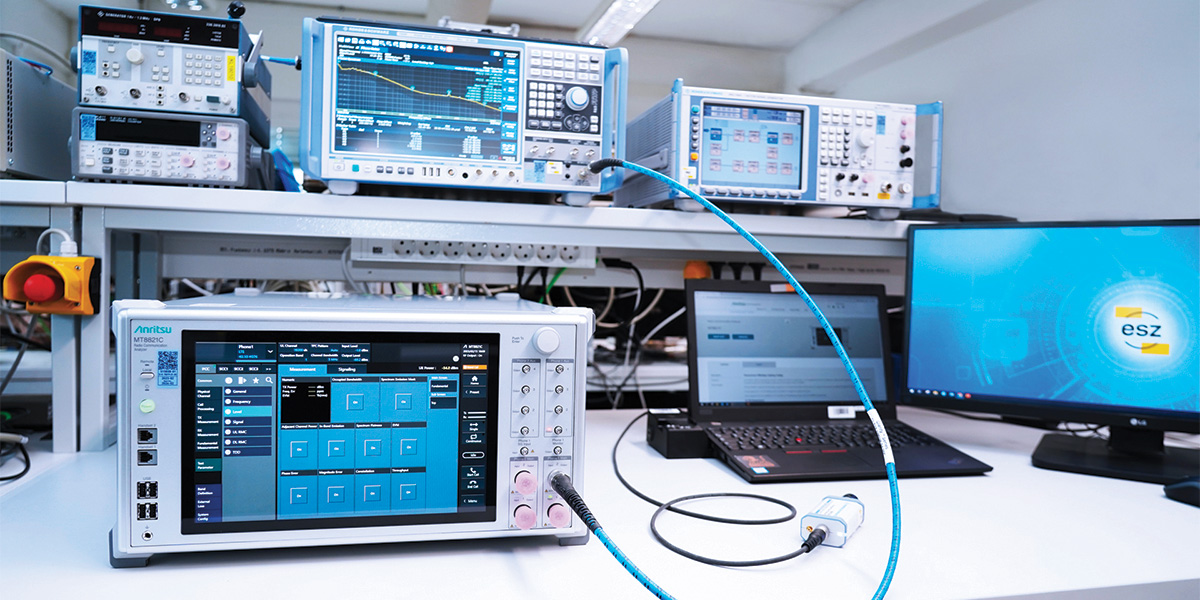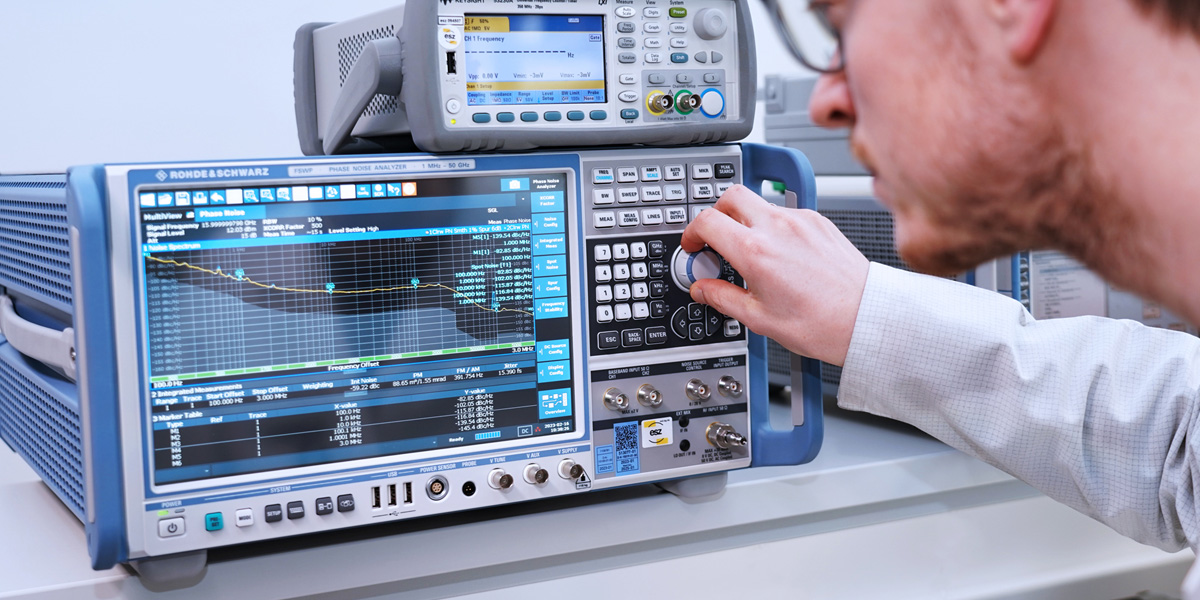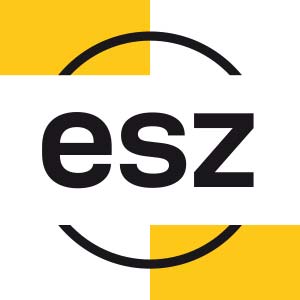High frequency
High Frequency Quantities
With measurement capabilities up to 67 GHz, esz AG’s high-frequency laboratory is one of the best-equipped laboratories in Europe. We use our reference devices to calibrate the RF standards of all users in the fields of communications electronics, telecommunications, avionics, radio communications and high-frequency technology as well as measuring devices from industry and research in Germany and abroad in various coaxial systems with traceability and maximum accuracy. The methods used correspond to the globally recognised state of the art and are carried out in a similar way in many leading calibration laboratories. Most high-frequency quantities are accredited by the German Accreditation Body (DAkkS).



Your calibration offer
We’ll be happy to provide you with a no obligation quote for the calibration of your measuring devices.

To the nearest 5 trillionth: Calibrations up to 67 GHz
Redundantly comparable via the GPS signal, normal frequency synthesis delivers measurement uncertainties of less than 5 trillionths of the time. The high-frequency laboratory is equipped with RF power measurement systems from various manufacturers, frequency and power ranges and connector systems. This guarantees the shortest response times.
Calibration of EMC measurement technology
Electromagnetic compatibility (EMC) measurement technology is concerned with measuring interference and testing the immunity of devices. We carry out these calibrations on our EMC measuring stations on the basis of various standards. The measurement, testing and assessment of the electromagnetic compatibility of electrical equipment is the responsibility of manufacturers and their EMC laboratories or independent service providers (conformity assessment bodies) for EMC measurement as part of the CE marking. For this reason, international standardisation organisations such as IEC, CENELEC and CISPR are also playing an increasingly important role in Germany.
In the esz AG laboratories, we always calibrate EMC interference generators, EMC accessories and EMC auxiliary devices in accordance with the applicable and latest guidelines.


Service
Logistics Expert
With the esz AG collection and delivery service, your sensitive test equipment is always in safe hands. Choose between individual collection and delivery or our weekly delivery service with fixed routes.
Your benefits
- Full-Service – everything from a single source
- DAkkS-accredited calibration of almost all high-frequency test equipment
- Calibrations up to 67 GHz
- Measurement uncertainty less than 5 trillionths of the time
- Repair, adjustment and calibration possible in our own service laboratory
More information
DAkkS & Factory/ISO calibration
- High-frequency quantities
- HF voltage
- HF current
- HF impedance (reflection factor)
- HF Power
- HF attenuation
- Pulse quantities
- Oscilloscope quantities
- Rise time
- Bandwidth
- HF noise
- Modulation quantities
- HF power meters
- HF signal generators Spectrum analysers
- Attenuators
- Measuring receiver
- Radio measuring stations
- Frequency counter
- EMC devices
- Coupling networks
- Mesh replicas
- HF filter
- HF components
- HF calibration kits
- Phase noise measuring stations
To calibrate high-frequency power, the power generated by a generator is measured in several measurements on a symmetrical power splitter and compared with the display values of the calibration object. In order to record the frequency response and linearity of power sensors or measuring devices, up to four measurements are carried out per frequency. Rotation is required to determine whether a connector is damaged. This occurs precisely when the standard deviation between the individual measurements is significantly higher than the typical type A uncertainty of the connector type.
HF power calibration over 20 decades
With calibrated attenuators, even extremely sensitive power sensors, spectrum analysers or measuring receivers can be precisely calibrated at minimum power levels. In order to achieve maximum accuracy, the scattering parameters of the attenuators must be corrected. For this purpose, the complex input reflection coefficients of the DUT, the complex equivalent output reflection coefficient of the output port of the power splitter and the scattering parameters of the attenuator in terms of magnitude and phase are used. In this way, the reference plane can be shifted mathematically.
When calibrating signal generators, high-end measuring receiver systems are used that offer an unprecedented dynamic range of -130 dBm to +20 dBm. In addition, phase noise measuring stations enable precise determination of the single-sideband phase noise with very high sensitivity of up to -190 dBc/Hz. Single sideband phase noise measurements are possible in a wide frequency range from 1 MHz to 40 GHz.
We use vector network analysers to measure reflection coefficients and attenuation in the frequency range from 9 kHz to 45 GHz.
After a complete calibration with one port (or two ports, three or four ports), our devices enable the precise determination of the complex reflection coefficient gamma, the attenuation, or the complex scattering parameters of a test specimen in terms of magnitude and phase. Direct traceability is achieved through the use of transfer and verification standards. These are calibration sets (open, short, load), mismatches and attenuators of the “target” connector systems.
The transfer standards are recorded by a national metrology institute, where they are traced back to SI units by means of primary experiments. The measurement uncertainty is calculated in accordance with the publication EURAMET Guides No. 12-2018/03 using the model for the rigorous determination of measurement uncertainty.
Ambient conditions and short-term stabilities of less than 0.5 Kelvin
The calibration procedure for the attenuation calibration for high attenuation values is achieved as a direct measurement procedure in relation to the continuity measurement with short circuit of transmitter and receiver (THRU) on selective measuring systems. If the reference measurement and insertion of the measurement object are carried out at the same time, the temperature influence is kept very low under ambient conditions and short-term stabilities of less than 0.5 K.
As the initiator of the DKD-L 02/1 series of calibration guidelines, esz AG is significantly involved in the development of guidelines and documents that facilitate the calibration, handling of traceability and accreditation of so-called derived high-frequency quantities. Quantities such as display linearity, IF gain, bandwidth, filter slope, modulation or noise display (DANL) can then be found not only exclusively on factory calibration certificates, but also on accredited calibration certificates.
Guidelines and committee work create clear requirements
The gap caused by the fact that these quantities play no role in the transfer of the units of the state institutes or primary laboratories is finally closed by the definition and allocation of the auxiliary RF measured values. Complex measurement objects such as measurement receivers, spectrum analysers or signal generators can then be fully represented within accredited calibrations and are also transparently available to all partners and clients of esz AG. In addition, esz AG is also involved in the ongoing guideline work of the VDI GMA 3.12 technical committee for electrical quantities, so that practical feedback from industry, science and research is provided and can be taken into account in the description of calibration procedures and measurement uncertainty.
The susceptibility to interference from currents, voltages, conducted or radiated interference can only be verified with EMC interference generators whose electrical properties are known and have been verified in the course of measuring the susceptibility to interference with an EMC interference generator during calibration. The core statements such as traceable calibration, application of the special test standard and DIN EN ISO/IEC 17025 calibration are the focus for many EMC service providers and their certifications as test laboratories.
In the esz AG laboratories, we always calibrate EMC interference generators, EMC accessories and EMC auxiliary devices in accordance with the applicable and latest guidelines. This includes, for example, the verification and calibration of the properties of devices or generators with requirements for
- Interference emission (DIN EN 55022 or 55014 / 55011)
- Harmonics / Harmonic waves (DIN EN 61000-3-2 or DIN EN 61000-4-7)
- ESD immunity (DIN EN 61000-4-2)
- Burst immunity (DIN EN 61000-4-4)
- Surge immunity (DIN EN 61000-4-5)
- HF electromagnetic or induced (DIN EN 61000-4-3 or DIN EN 61000-4-6)
- Power failure (dips/interruptions) (DIN EN 61000-4-11) or
- Flicker (EN 61000-4-15)
esz AG publishes all calibration procedures. You can download the quality management manual here.

